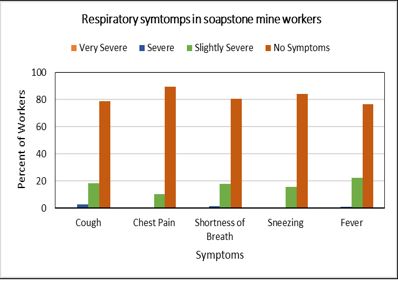Analyzing the Impacts of Soapstone Dust on Respiratory System of Mine Workers Through Structural Equation Modelling Technique: A Case Study of Sherwan Soapstone Mines, Abbottabad, Pakistan
Keywords:
Dust Inhalation, Severity, Respiratory Symptoms, Medical Examination, Structural Equation ModellingAbstract
Dust produced in mining has a substantial impact on worker’s health resulting in severe respiratory diseases. Researchers mainly focused on the dust problems faced in surface mining whereas the dust produced in underground soapstone mines has received comparatively less attention. This study evaluates self-reported respiratory symptoms and medical examinations of underground mine workers in soapstone mines. It establishes a relationship between the respiratory illness factors and its symptoms, providing new insight into the analysis. Demographic and other respiratory symptoms-related data is collected through questionnaires from underground soapstone mine workers, located in the Abbottabad area, with medical data from 60 of these workers obtained through medical examinations. The collected data is subsequently analyzed using Structural Equation Modelling and regression analysis to investigate the relationship between the evaluated factors in the dust analysis. The dust assessment shows that it is primarily composed of silica, with small particle sizes that are smaller than the threshold limit value and pose a risk of silicosis. The questionnaire data indicates that about 75% of workers exhibit symptoms of respiratory diseases, the majority of them are laborers and old age workers whereas the medical examinations revealed that 80% of workers are affected by lung infections. The Structural Equation Modelling demonstrates that dust inhalation has a stronger effect on symptom occurrence (β = 0.485, p < 0.001) compared to dust severity (β = 0.207, p < 0.05). These results are concerning and underscore the need for interventions, and the adoption of adequate respiratory protection measures for safeguarding the health of workers.
References
“Soapstone Deposit of the Sherwan Area Hazara District, Pakistan”, [Online]. Available: https://pubs.usgs.gov/of/1973/0041/report.pdf
“The dangers of mining around the world - BBC News.” Accessed: Sep. 17, 2024. [Online]. Available: https://www.bbc.com/news/world-latin-america-11533349
“Coal miners become casualties in Pakistan : Peoples Dispatch.” Accessed: Sep. 17, 2024. [Online]. Available: https://peoplesdispatch.org/2020/02/03/coal-miners-become-casualties-in-pakistan/
M. H. Ross and J. Murray, “Occupational respiratory disease in mining,” Occup. Med. (Lond)., vol. 54, no. 5, pp. 304–310, Aug. 2004, doi: 10.1093/OCCMED/KQH073.
B. Saima Shihepo, O. Awofolu, and N. Hamatui, “Assessment of dust exposure and risk of chronic respiratory diseases among stone corrie quarry workers in Namibia, 2018.” 2019. Accessed: Sep. 17, 2024. [Online]. Available: http://ir.nust.na/jspui/handle/10628/709
L. J. Gross, P. De Treville, R. T. P., Cralley, “Studies on the carcinogenic effects of asbestos dust,” Pneumocon. Proc. an Int. Conf. Johannesburg, 1969, Ed. by H. A. Shapiro Oxford Univ. Press. London, pp. 220–224, 1970.
R. A. Harley, “Asbestos-Induced intrathoracic tissue reactions,” Arch. Pathol., vol. 96, 1973.
J. Deer, W. A., Howie, R. A., Zussman, “Rock Forming Minerals,” Longman, London, vol. 3, pp. 121–123, 1962.
G. Y. Hildick Smith, “The biology of talc.,” Br. J. Ind. Med., vol. 33, no. 4, p. 217, 1976, doi: 10.1136/OEM.33.4.217.
S. Jaleel and S. Raza, “Analysis of Dust Produced at Soapstone Mines Abbottabad, Pakistan,” IJSRD-International J. Sci. Res. Dev., vol. 11, pp. 2321–0613, 2023, Accessed: Sep. 17, 2024. [Online]. Available: www.ijsrd.com
“Respirable vs Inhalable Dust: Health Risks, and Control Strategies.” Accessed: Sep. 17, 2024. [Online]. Available: https://oizom.com/respirable-vs-inhalable-dust/
İ. Koyuncu and A. F. Kılıç, “The Use of Exploratory and Confirmatory Factor Analyses: A Document Analysis *,” Educ. Sci., vol. 44, pp. 361–388, 2019, doi: 10.15390/EB.2019.7665.
S. Sherin, S. Raza, and I. Ahmad, “Conceptual Framework for Hazards Management in the Surface Mining Industry—Application of Structural Equation Modeling,” Safety, vol. 9, no. 2, p. 31, Jun. 2023, doi: 10.3390/SAFETY9020031/S1.
L. Zhang, H. Chen, H. Li, X. Wu, and M. J. Skibniewski, “Perceiving interactions and dynamics of safety leadership in construction projects,” Saf. Sci., vol. 106, pp. 66–78, Jul. 2018, doi: 10.1016/j.ssci.2018.03.007.
M. Neghab, R. Abedini, A. Soltanzadeh, A. Iloon Kashkooli, and S. M. A. Ghayoomi, “Respiratory disorders associated with heavy inhalation exposure to dolomite dust,” Iran. Red Crescent Med. J., vol. 14, no. 9, p. 549, 2012, Accessed: Sep. 17, 2024. [Online]. Available: /pmc/articles/PMC3482327/
P. S. Paul, “Investigation of the role of personal factors on work injury in underground mines using structural equation modeling,” Int. J. Min. Sci. Technol., vol. 23, no. 6, pp. 815–819, Nov. 2013, doi: 10.1016/J.IJMST.2013.10.006.
P. S. Paul and J. Maiti, “The role of behavioral factors on safety management in underground mines,” Saf. Sci., vol. 45, no. 4, pp. 449–471, Apr. 2007, doi: 10.1016/J.SSCI.2006.07.006.
F. Rajabi, H. Mokarami, R. Cousins, and M. Jahangiri, “Structural equation modeling of safety performance based on personality traits, job and organizational-related factors,” Int. J. Occup. Saf. Ergon., vol. 28, no. 1, pp. 644–658, 2022, doi: 10.1080/10803548.2020.1814566.
S. Supardi and D. Sudiantini, “How the Mediation Effect of Job Stress on the Relationship between Safety Leadership , Safety Culture and Safety Performance,” vol. 5, no. 2, pp. 434–441, 2024.
K. M. Pule Mphahlele, Crizelle Els, Leon T. De Beer, “Investigating strengths and deficits to increase work engagement : A longitudinal study in the mining industry”, [Online]. Available: https://sajhrm.co.za/index.php/sajhrm/article/view/900

Downloads
Published
How to Cite
Issue
Section
License
Copyright (c) 2024 50SEA

This work is licensed under a Creative Commons Attribution 4.0 International License.




















